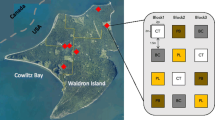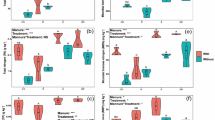Abstract
Purpose
Organic treatments may improve soil nutrient availability and ecological functions. This study aimed to determine the effect of biogas slurry (BS) on soil properties, yields, and bacterial community activity and to examine the main environmental factors impacting bacterial compositions in the ecosystem.
Materials and methods
A 3-year field experiment was conducted in yellow soil under a rice-rape rotation to understand the effect of BS originating from anaerobically digested pig waste on soil chemical and bacterial compositions.
Results and discussion
Compared with an inorganic nutrient treatment and a control, adding BS at a moderate dose (BS6, 165.1 t ha−1) positively affected the rice and rape yields, soil fertility, and bacterial diversity. The BS was more suitable than chemical fertilizer for maintaining agricultural soil sustainability, especially the BS6 and BS7 treatments (165.1 and 182.1 t ha−1, respectively), by improving nutrient content, increasing soil pH, and promoting soil crumb structure formation. The relative abundance of Actinobacteria in BS6 was decreased by 37.9% compared with the untreated soil and 27.7% compared with the fertilizer treatment, while the relative abundance of Nitrospirae in BS6 increased by 41.2% and 43.5% compared with these treatments, respectively. Redundancy analyses (RDA) showed that pH, rape yield, cation exchange capacity (CEC), and total nitrogen (TN) were significantly correlated with soil bacterial community composition and explained 56.0%, 46.4%, 43.2%, and 34.9% of the total community variability, respectively. The soil bacterial diversity depended mainly on soil pH, and crop rotation played an important role in changing the bacterial community.
Conclusions
The soil bacterial composition was clearly altered after 3 years of BS treatments. These increases in bacterial diversity could be of ecological significance in maintaining soil fertility and functionality.



Similar content being viewed by others
References
Abubaker J, Cederlund H, Arthurson V, Pell M (2013) Bacterial community structure and microbial activity in different soils amended with biogas residues and cattle slurry. Appl Soil Ecol 72:171–180
Abubaker J, Risberg K, Pell M (2012) Biogas residues as fertilisers-effects on wheat growth and soil microbial activities. Appl Energy 99:126–134
Banik S, Nandi R (2004) Effect of supplementation of rice straw with biogas residual slurry manure on the yield, protein and mineral contents of Volvariella volvacea mushroom. Ind Crop Prod 20:311–319
Bao S (2008) Soil agricultural chemistry analysis. China Agriculture Press, Beijing
Yousuf B, Sanadhya P, Keshri J, Jha B (2012) Comparative molecular analysis of chemolithoautotrophic bacterial diversity and community structure from coastal saline soils, Gujarat, India. BMC Microbiol 12:150–165
Bending GD, Turner MK, Jones JE (2002) Interactions between crop residue and soil organic matter quality and the functional diversity of soil microbial communities. Soil Biol Biochem 34:1073–1082
Bharde NM, Shivay YS, Singh S (2003) Effect of biogas slurry and neem oil-treated urea sources on rice (Oryza sativa)-wheat (Triticum aestivum) cropping system. Indian J Agron 48:73–77
Bodenhausen N, Horton MW, Bergelson J (2013) Bacterial communities associated with the leaves and the roots of Arabidopsis thaliana. PLoS One 8:1–9
Chen C et al (2016) Microbial communities of an arable soil treated for 8 years with organic and inorganic fertilizers. Biol Fertil Soils 52:1–13
Chodak M, Gołębiewski M, Morawska-Płoskonka J, Kuduk K, Niklińska M (2013) Diversity of microorganisms from forest soils differently polluted with heavy metals. Appl Soil Ecol 64:7–14
Elzobair KA, Stromberger ME, Ippolito JA, Lentz RD (2016) Contrasting effects of biochar versus manure on soil microbial communities and enzyme activities in an Aridisol. Chemosphere 142:145–152
Erenstein O, Laxmi V (2008) Zero tillage impacts in India’s rice–wheat systems: a review. Soil Tillage Res 100:1–14
Fadrosh DW, Ma B, Gajer P, Sengamalay N, Ott S, Brotman RM, Ravel J (2014) An improved dual-indexing approach for multiplexed 16S rRNA gene. Microbiome 2:2–7
Galvez A, Sinicco T, Cayuela ML, Mingorance MD, Fornasier F, Mondini C (2012) Short term effects of bioenergy by-products on soil C and N dynamics, nutrient availability and biochemical properties. Agric Ecosyst Environ 160:3–14
Garbeva P, Van Veen JA, Van Elsas JD (2004) Microbial diversity in soil: selection of microbial populations by plant and soil type and implications for disease suppressiveness. Annu Rev Phytopathol 42:243–270
Geisseler D, Scow KM (2014) Long-term effects of mineral fertilizers on soil microorganisms – a review. Soil Biol Biochem 75:54–63
Gu YF et al (2017) Long-term fertilization structures bacterial and archaeal communities along soil depth gradient in a paddy soil. Front Microbiol 8: 1–15
Griffiths RI, Thomson BC, James P, Bell T, Bailey M, Whiteley AS (2011) The bacterial biogeography of British soils. Environ Microbiol 13:1642–1654
Har-Peled S, Sharir M, Varadarajan KR (2015) The effects of biochar and compost amendments on copper immobilization and soil microorganisms in a temperate vineyard. Agric Ecosyst Environ 201:58–69
Jiang Y, Liang Y, Li C, Wang F, Sui Y, Suvannang N, Zhou J, Sun B (2016) Crop rotations alter bacterial and fungal diversity in paddy soils across East Asia. Soil Biol Biochem 95:250–261
Kuffner M, Hai B, Rattei T, Melodelima C, Schloter M, Zechmeister-Boltenstern S, Jandl R, Schindlbacher A, Sessitsch A (2012) Effects of season and experimental warming on the bacterial community in a temperate mountain forest soil assessed by 16 S r RNA gene pyrosequencing. FEMS Microbiol Ecol 82:551–562
Ladha JK et al (2004) Long-term effects, of organic inputs on yield and soil fertility in the rice-wheat rotation. Soil Sci Soc Am J 68:845–853
Marschner P, Kandeler E, Marschner B (2003) Structure and function of the soil microbial community in a long-term fertilizer experiment. Soil Biol Biochem 35:453–461
Navarrete AA, Kuramae EE, de Hollander M, Pijl AS, van Veen JA, Tsai SM (2013) Acidobacterial community responses to agricultural management of soybean in Amazon forest soils. FEMS Microbiol Ecol 83:607–621
Niyungeko C et al (2018) Effect of biogas slurry application rate on colloidal phosphorus leaching in paddy soil: a column study. Geoderma 352:117–124
Nozomi Y, Kenichi O, Yutaka N (2009) Bacterial communities developing during composting processes in animal manure treatment facilities. Asian-Aus J Ani Sci 22:900–905
Odlare M, Pell M, Svensson K (2008) Changes in soil chemical and microbiological properties during 4 years of application of various organic residues. Waste Manag 28:1246–1253
Ozores-Hampton M, Stansly PA, Salame TP (2011) Soil chemical, physical, and biological properties of a sandy soil subjected to long-term organic amendments. J Sustain Agric 35:243–259
Prosser JI, Bohannan BJM, Curtis TP, Ellis RJ, Firestone MK, Freckleton RP, Green JL, Green LE, Killham K, Lennon JJ, Osborn AM, Solan M, van der Gast CJ, Young JPW (2007) The role of ecological theory in microbial ecology. Nat Rev Microbiol 5:384–392
Shankarappa TH, Gurumurthy SB, Patil SV, Lokesh MS (2012) Influence of phosphate enriched biogas spent slurry (BSS) on growth and yield of sunflower (Helianthus annuus). Int J Plant Sci 3:253–258
Shen J-P, Zhang L-M, Guo J-F, Ray JL, He J-Z (2010) Impact of long-term fertilization practices on the abundance and composition of soil bacterial communities in Northeast China. Appl Soil Ecol 46:119–124
Sieling K, Herrmann A, Wienforth B, Taube F, Ohl S, Hartung E, Kage H (2013) Biogas cropping systems: short term response of yield performance and N use efficiency to biogas residue application. Eur J Agron 47:44–54
Stroobants A, Degrune F, Olivier C, Muys C, Roisin C, Colinet G, Bodson B, Portetelle D, Vandenbol M (2014) Diversity of bacterial communities in a profile of a winter wheat field: known and unknown members. Microb Ecol 68:822–833
Terhoeven-Urselmans T, Scheller E, Raubuch M, Ludwig B, Joergensen RG (2009) CO2 evolution and N mineralization after biogas slurry application in the field and its yield effects on spring barley. Appl Soil Ecol 42:297–302
Timsina J, Connor DJ (2001) Productivity and management of rice-wheat cropping systems: issues and challenges. Field Crop Res 69:93–132
Wang K, Yang Y, Bell RW, Xue JM, Ye ZQ, Wei YZ (1999) Low risks of toxicity from boron fertiliser in oilseed rape–rice rotations in southeast China. Nutr Cycl Agroecosyst 54:189–197
Wang X, Song D, Liang G, Zhang Q, Ai C, Zhou W (2015) Maize biochar addition rate influences soil enzyme activity and microbial community composition in a fluvo-aquic soil. Appl Soil Ecol 96:265–272
Wang Y, Ji H, Gao C (2016) Differential responses of soil bacterial taxa to long-term P, N, and organic manure application. J Soils Sediments 16:1046–1058
Wentzel S, Schmidt R, Piepho HP, Semmlerbusch U, Joergensen RG (2015) Response of soil fertility indices to long-term application of biogas and raw slurry under organic farming. Appl Soil Ecol 96:99–107
Win AT, Toyota K, Win KT, Motobayashi T, Ookawa T, Hirasawa T, Chen D, Lu J (2014) Effect of biogas slurry application on CH4 and N2O emissions, Cu and Zn uptakes by whole crop rice in a paddy field in Japan. Soil Sci Plant Nutr 60:411–422
Xu HJ, Wang XH, Li H, Yao HY, Su JQ, Zhu YG (2014) Biochar impacts soil microbial community composition and nitrogen cycling in an acidic soil planted with rape. Environ Sci Technol 48:9391–9399
Xu N, Tan G, Wang H, Gai X (2016) Effect of biochar additions to soil on nitrogen leaching, microbial biomass and bacterial community structure. Eur J Soil Biol 74:1–8
Yan-li Z (2012) Effects of application of biogas slurry of pig dung on physical and chemical properties of soil. J Anhui Agric Sci 40:15202–15203,15213
Yi-qi W, Wen-biao H, Yu-zhu Z (2016) Effects of biogas slurry on soil physical and chemical properties. J Anhui Agric Sci 44:193–195
Zhao J et al (2014) Responses of bacterial communities in arable soils in a rice wheat cropping system to different fertilizer regimes and sampling times. PLoS One 9:1–10
Zheng J, Chen J, Pan G, Liu X, Zhang X, Li L, Bian R, Cheng K, Jinwei Z (2016) Biochar decreased microbial metabolic quotient and shifted community composition four years after a single incorporation in a slightly acid rice paddy from southwest China. Sci Total Environ 571:206–217
Zheng X, Fan J, Cui J, Wang Y, Zhou J, Ye M, Sun M (2015) Effects of biogas slurry application on peanut yield, soil nutrients, carbon storage, and microbial activity in an Ultisol soil in southern China. J Soils Sediments 16:449–460
Zhou J, Jiang X, Zhou B, Zhao B, Ma M, Guan D, Li J, Chen S, Cao F, Shen D, Qin J (2016) Thirty four years of nitrogen fertilization decreases fungal diversity and alters fungal community composition in black soil in northeast China. Soil Biol Biochem 95:135–143
Zirkler D, Peters A, Kaupenjohann M (2014) Elemental composition of biogas residues: variability and alteration during anaerobic digestion. Biomass Bioenergy 67:89–98
Acknowledgements
This work was supported by the Provincial Science and Technology Support Program of Sichuan (2014NZ0045, 2016NZ0039).
Author information
Authors and Affiliations
Corresponding author
Additional information
Responsible editor: Yuan Ge
Publisher’s note
Springer Nature remains neutral with regard to jurisdictional claims in published maps and institutional affiliations.
Rights and permissions
About this article
Cite this article
Xu, M., Xian, Y., Wu, J. et al. Effect of biogas slurry addition on soil properties, yields, and bacterial composition in the rice-rape rotation ecosystem over 3 years. J Soils Sediments 19, 2534–2542 (2019). https://doi.org/10.1007/s11368-019-02258-x
Received:
Accepted:
Published:
Issue Date:
DOI: https://doi.org/10.1007/s11368-019-02258-x




